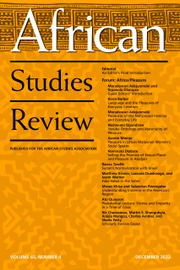Contrary to most previous studies that focus more on religion, religious groups, and inter-faith relations, Religious Plurality in Africa offers a compelling and deeply researched account of the historical, cultural, and theological dynamics of religious plurality across the African continent. In an era where religious diversity increasingly shapes the social and political landscapes of various African societies, the book draws on relevant and convincing case studies from East and West Africa, exploring how Islam, Christianity, and African religious traditions coexist, compete, and, in some cases, converge in complex ways.
Being a collection of eight well-researched chapters that draw on ethnographic case studies, primary, and secondary data, and are written by anthropologists, religious studies scholars, and historians who are experts on Islam, Christianity, and African religious traditions, Religious Plurality in Africa is logically structured into three broad parts. While the first section focuses on studying religious entanglements, using Kenya, Mozambique, and Ghana as case studies, the second explains the nature and dynamics of inter- and intra-religious relations between and within followers of Islam, Christianity, and African religious traditions. These entanglements, especially in the public domain, emphasize the “C”-laden experiences of coexistence, conviviality, and conflicts to interpret the contours of human interaction in plural settings. The third part analyzes the notions of well-being and healing within various African religious traditions, particularly relating to the place of Islamic medicine in Zanzibar and the roles of Islamic scholars (referred to in Hausa as Mallamai) in providing guidance and healing services to the followers of different religious groups in Ghana’s multiple religious spaces.
Considering the complex canvas of religious plurality in Africa, which sometimes appears seemingly contradictory, the book shows how different religious groups cohabitate and struggle to construct shared meanings and common spaces.
The book challenges the common and often simplistic narratives surrounding the concepts of conflict and syncretism when discussing religious plurality. Instead, it presents nuanced perspectives on African religious life as fluid, context-specific, and embedded in everyday life. The work enriches our understanding of the African religious identities and thus contributes meaningfully to the ongoing debates on pluralism and coexistence.
The book is an important contribution to the field of religion in Africa. The book offers a unique conceptual and methodological reflection that is lacking in previous studies on religion in Africa. In so doing, the book promotes a new perspective about religion(s) in Africa based on its relationality, entanglement, and multiplicity. Unlike previous studies that mostly view African spiritual ideas and practices through the lens of “African Traditional Religion,” which is degrading to the African people, the book attempts a conceptualization of the term “African Religious Tradition” (ART), which it argues to be more robust and pragmatic, capable of engaging with power resources in making relations, while achieving healing and well-being that is also peculiar to both Islam and Christianity.
Using terms such as relationality, multiplicity, and entanglement, the book emphasizes connections rather than closures, different from the approaches used by most studies on religion and interfaith relations on the African continent. In emphasizing these religious and relational connections, the book offers new insight into the inter- and intra-relations between different religious groups. It also traces and compares the various ways in which African people live and experience religious plurality. Thus, moving away from the conventional reification of religions and their differences, the book adopts a purely relational perspective to the study of religions and their relations in Africa.
Despite its contribution to religious plurality in Africa, one notable shortcoming of the book is its generalization of complex religious experiences across diverse African contexts without fully accounting for regional particularities. Although the book’s comparative approach is valuable, it often glosses over the deeply localized ways in which religious identities are shaped by their historical experiences, such as ethnic histories, colonial legacies and the current socio-political factors defining the nature and dynamics of religious plurality in Africa. Additionally, though included, African religion does not receive the same depth of theological and philosophical engagement as Islam and Christianity. This problem also reinforces the marginalization of African religion in academic discourse. Although the book attempts to mark a departure “from the simplifying label” of “African Traditional Religion” and opts to use “African Religious Tradition,” the term still falls short of the meaning and true essence of African religion. Instead of qualifying it with pronouns such as “Traditional” or “Religious Traditions,” it would be better if it is simply called “African Religion.”
However, the book is no doubt important not only because it reconceptualizes the concepts of relationality and religious entanglement, but also redefines and contextualizes the notion of religious plurality, embodying the existence of diverse traditions in a common space and multiple relations that take place. Thus, Religious Plurality in Africa is relevant, especially to Africanist scholars, historians, political scientists, scholars of religion, anthropologists, and anyone interested in learning and knowledge production in Africa and beyond.

